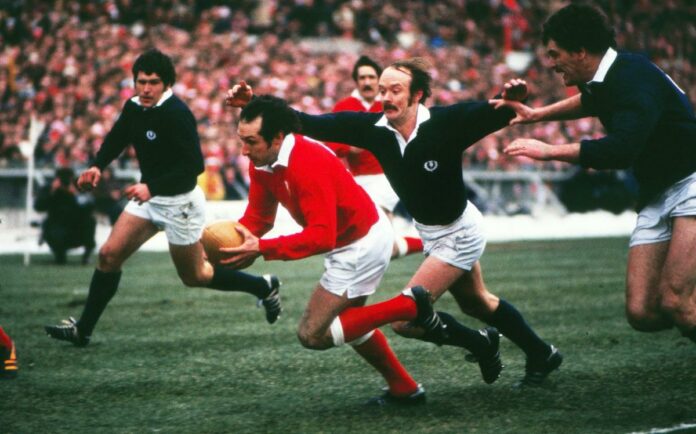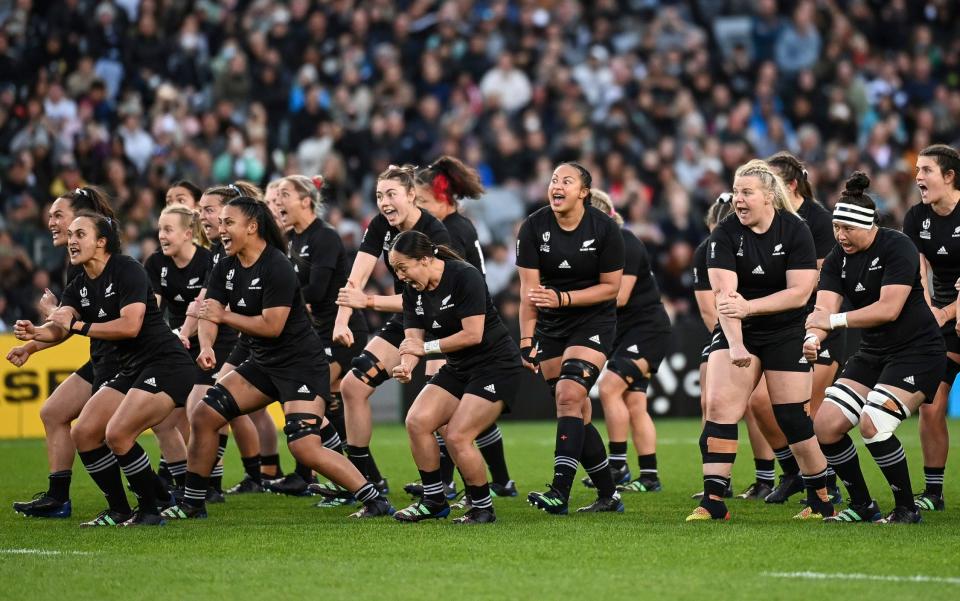
[ad_1]
Gareth Edwards was a vital cog in the Wales’ side throughtou the late 1960s and 1970s – Colorsport/Corbis
The Springboks’ Rugby Championship victory has sparked debate about where they sit in the pantheon of the greatest international teams of all time.
Under Rassie Erasmus, they can boast two World Cups, a Lions series victory and now a domination of the southern hempishere, too.
Telegraph Sport’s rugby experts put forward who they think should be regarded as rugby’s greatest side. You can vote for your favourite in the poll below.
Wales: 1969-1979
“Let’s start with the King in Cardiff, Barry John.” Just writing the words evokes childhood memories of watching the BBC’s epic video ‘101 Best Tries’ video too many times. That it was the late great Cliff Morgan who delivered the intro, teeing up John’s try against Scotland in 1969, could not have been more appropriate. Morgan was regarded as one of Wales’ greatest fly-halves from the 1950s, and the video was littered with stunning tries from his country’s greatest period, from 1969 to 1979. The statistics show that this was a decade when Wales dominated the old Five Nations Championship, winning six titles outright, including three Grand Slams. But their collective achievements went far beyond silverware. The Wales team served up rugby from a different world, a mix of breath-taking attacking flair backed up by fearsome forward heft. That they were able to sustain their success for a decade from a relatively modest playing base makes it an even more remarkable achievement.
Morgan’s choice to open with Barry John was not by chance. John is regarded as one of the greatest fly-halves to have played the game before his shock retirement at the age of just 27. Yet the great Welsh fly-half factory ensured that the country did not miss a step, with another legend stepping up to take his place in Phil Bennett. Both were a joy to watch, at a time when attacking sides had more time and space on the ball to weave their magic. And both were blessed with play with the greatest scrum-half to have played the game, Gareth Edwards in a team that boasted generational talent including JPR Williams, Gerald Davies, Gareth Davies, JJ Williams, Ray Gravell, John Dawes, John Bevan, Mervyn Davies, John Taylor and not forgetting the famous Pontypool front row of Graham Price, Bobby Windsor and Charlie Faulkner.
At a time when there was no World Cup to define the world’s best teams, the Welsh side of this decade can be measured on the impact they had on the British and Irish Lions against New Zealand and South Africa. The 1971 tour of New Zealand is regarded as the tour that changed the way the game is played in New Zealand, the country with the greatest overall record in international rugby. While the 1974 Lions returned from their brutal tour of South Africa heralded as the ‘Invincibles,’ winning 21 of their 22 games, and drawing the fourth and final Test. Both sides were stacked with Welsh players, while Edwards scored what is widely regarded as the greatest try of all time in 1973 for the Barbarians against New Zealand in Cardiff.
Gavin Mairs
Australia: 1984
Australia’s current malaise hits home even harder when one considers that, 40 years ago, they ruled the world.
The 1984 Wallabies arrived on the shores of the United Kingdom and Ireland to little fanfare having lost the Bledisloe series to New Zealand that summer. But those losses – alongside one victory – were narrow; and under new head coach Alan Jones, Australia were building something special. In the end, the ‘84 Wallabies obliterated all in their wake, becoming the first and only Australian side to achieve a Grand Slam against the four Home Nations, with the tour acting as a springboard for the nation’s quest for world domination. Two World Cup victories followed in the ensuing 15 years.
The highlights reel from that tour, available on YouTube, is worth 10 minutes of any rugby fan’s time. For anyone doubting the class on show, Michael Lynagh, widely regarded as one of the game’s greatest fly-halves, had to make do with a spot at inside centre as the majestic Mark Ella ran the show. Ella scored a try in every Test on the tour and, along with the likes of Lynagh and swashbuckling David Campese, brought an attacking instinct and awareness that had been seldom seen before. Many modern teams would do well to watch how the trio, alongside the cerebral Nick Farr-Jones, were able to manipulate and exploit space, and their refusal to die with the ball in contact. The same was true up front, too, where the likes of Simon Poidevin and Steve Tuynman showed that the future of forward play combined both elegance and aggression.
Charles Richardson
Springboks: 2019-present
Given their recent success in the Rugby Championship, there is no suggestion that this current era of dominance by South Africa is coming to an end any time soon. Nearly all of their core players are still around and motivated to achieve an unprecedented feat in Australia in 2027 by winning three World Cups in a row. And while there is a decent argument to be made that in terms of collective talent this South Africa side may fall slightly short of the great All Blacks side from the previous decade, the amount of sheer grit and will to win, as we saw with those multiple one-point victories in knockout games at last year‘s Rugby World Cup, has separated South Africa from the rest of the pack. Not forgetting that the strangest Lions series of all was won thanks to a penalty by a fly-half in his late 30s. When it comes to winning the tight games, this South Africa side have just had something different to everyone else.
It feels like a lifetime ago but the rapid turnaround which Rassie Erasmus instigated back in 2018 before winning the World Cup the following year remains extraordinary, breathing new life into South Africa’s traditional strength of dominant set-piece play by creating a side who thrived out wide through nimble wingers and became masters of the breakdown too. As well as just boshing the life out of their opponents.
If they can now negate those senior players ageing into their mid-30s by bringing in a new wave of talent, as they have already started doing successfully this year by using 49 players so far, then this South Africa side may well go down as the greatest. But even after World Cup victories in Japan and France, they are absolutely in the conversation.
Ben Coles
All Blacks: 2010-2015
The current Springboks sandwiched a British and Irish Lions series with their successive World Cup victories, while this New Zealand side ‘only’ drew with Warren Gatland’s men 2017. And I might never have become a rugby union tragic without the Wales team of the 1970s, which enchanted my father and allowed me to inherit his enthusiasm. But the back-to-back All Blacks led by Richie McCaw get my vote.
They certainly had a steely edge, yet moved the ball beautifully, picking off defenders with textbook passing as well as offloading out of contact. Sonny Bill Williams was just one of the wildcards that arrived and added a different dimension. Nehe Milner-Skudder, who became the encyclopaedia definition of the term ‘bolter’, was another.
In McCaw and Dan Carter, they boasted two veritable icons of the game and were driven by many more all-time greats including Kieran Read, Sam Whitelock, Brodie Retallick, Jerome Kaino, Aaron Smith and Ma’a Nonu. One could argue the toss for Ben Smith, Dane Coles and Conrad Smith. Other stars such as Beauden Barrett were just emerging. Julian Savea stormed onto the scene and plundered a truck-load of tries.
While they wobbled over the finishing line amid immense pressure to win the 2011 World Cup, they subsequently lost just three games over the next four-year cycle. Only then, thanks to Ireland and the Lions and, finally, Rassie Erasmus, did their grip loosen.
Charlie Morgan
Black Ferns: 2017-22
You could probably pick any World Cup winning Black Ferns team for this exercise but the team that successfully defended their crown on home soil in 2022 feels most apt. There are several reasons for this, from the calibre of players who delivered under pressure to the adversity the team overcame in the build up to lift the trophy.
This five-year period saw enormous transition across the women’s rugby landscape. A whole 23 years after men’s rugby union turned professional, New Zealand’s national women’s team became the first XVs women’s side to be offered paid contracts in 2018, in what was a watershed moment for the sport. England had previously funded a professional XVs programme in the run up to the 2017 World Cup before the money was pumped into its sevens programme. The Rugby Football Union would later follow New Zealand Rugby’s lead in dishing out paid XVs contracts in 2019, which would kickstart a golden period for the Red Roses.
Simon Middleton’s team were on a record-breaking 30-game winning streak by the time the 2022 World Cup final came around and were red-hot favourites to win. Despite a strong start, their game plan began to unravel after Lydia Thompson’s 19th minute red card for a high tackle on Portia Woodman-Wickliffe, which gave the Black Ferns time to recalibrate at the break before a commanding second half performance in front of 42,579 fans at Eden Park.

The Black Ferns’ 2022 World Cup-winning team perform the haka before a match against Australia – AP/Andrew Cornaga
Their victory, achieved under former All Blacks assistant coach Wayne Smith, was a miracle of sorts. Smith had been drafted in six months earlier to save the team’s World Cup campaign after former coach Glenn Moore resigned amid a damning cultural review into the Black Ferns’ set-up. Smith had old friends for company, including Sir Graham Henry and the former All Blacks scrum coaching guru, Mike Cron. Even if their rushed appointments raised questions about NZR’s apparent neglect of its women’s programme, their presence inevitably raised the profile of the women’s game in a way never seen before at a major tournament in the women’s game.
On the pitch, the Black Ferns thrived under pressure. Ruby Tui became one of the stars of the tournament with her engaging interviews and off-field charisma. Portia Woodman-Wickliffe, arguably one of the best wingers to have graced the women’s game, became the first player – male or female – to score 20 World Cup tries after surpassing Sue Day’s tally of 19. Legendary scrum-half Kendra Cocksedge anchored the team, but it was also the stage where new stars were born, from Georgia Ponsonby, Ayesha Leti-I’iga and Maia Roos, whose intervention to disrupt an England lineout sealed New Zealand’s sixth World Cup triumph.
Fiona Tomas
Have your say…
Broaden your horizons with award-winning British journalism. Try The Telegraph free for 3 months with unlimited access to our award-winning website, exclusive app, money-saving offers and more.
[ad_2]
Copyright for syndicated content belongs to the linked Source link


